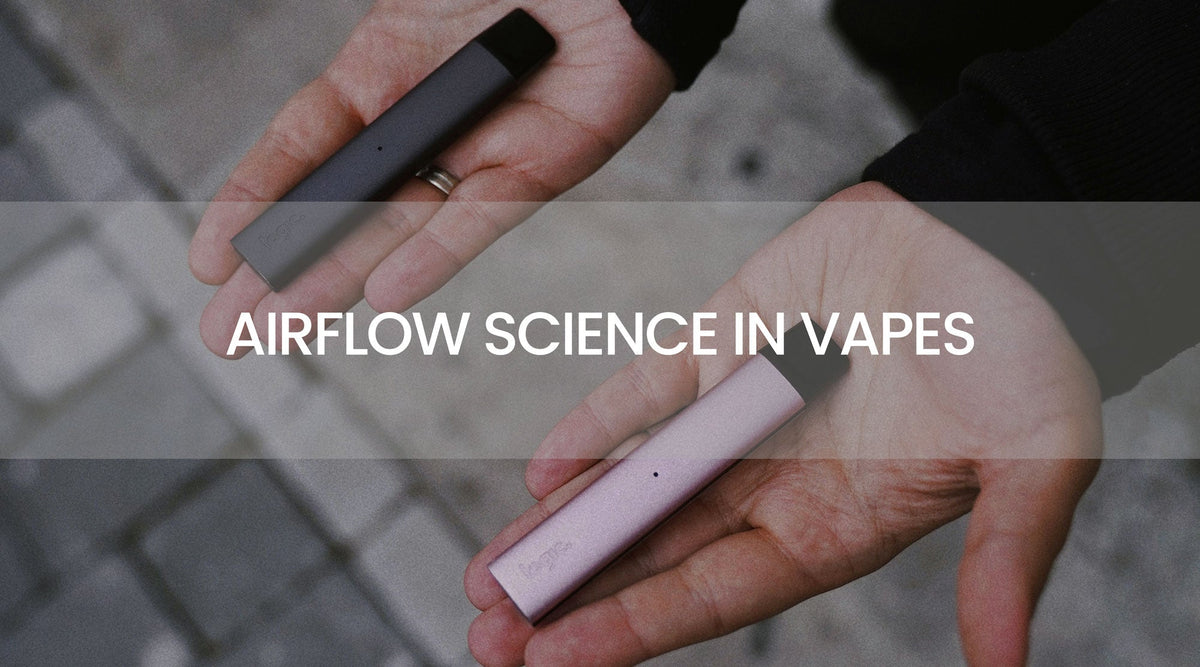
Airflow Science in Vapes: How Draw Resistance Changes Flavour and Throat Hit
|
Time to read 4 min
|
Time to read 4 min
Airflow is the most powerful flavour control you already have. Tighter airflow (higher resistance) concentrates warmth and boosts throat hit, great for MTL and salts.
Looser airflow (lower resistance) cools the vape, increases vapour volume and smooths the hit, ideal for DTL. Small tweaks - one airflow step and 2–3 W at a time - can rescue muted flavour, stop spitback and unlock your e-liquid’s best notes.
When you inhale, the tank or pod pulls in air through intake holes. That air moves across the coil and vapourises e-liquid.
Tighter airflow (small inlets/closed ring): higher air speed over the coil, warmer vapour, stronger throat hit, more concentrated flavour.
Looser airflow (large inlets/open ring): greater air volume, cooler vapour, bigger clouds, smoother finish.
You’ll also meet two airflow behaviours:
Laminar (smooth) flow: steadier warmth and cleaner flavour definition.
Turbulent (swirly) flow: more mixing and cloud volume, but can soften fine flavour notes.
The “right” feel is personal - the goal is to match airflow to nicotine strength, VG/PG ratio and coil design.
MTL (mouth-to-lung): tight draw, small inlets, higher resistance coils (≥1.0 Ω), modest wattage. Expect warm, concentrated flavour and pronounced throat hit. Suits nicotine salts and 50/50 e-liquids.
RDL (restricted direct-lung): medium draw, mid inlets, 0.6–0.9 Ω coils, moderate wattage. Balanced warmth, body and smoothness.
DTL (direct-to-lung): open draw, large inlets, low resistance coils (≤0.3 Ω), higher wattage. Cooler, dense vapour and softer throat hit. Suits 70/30 VG/PG freebase at low nicotine.
For a fuller primer on inhale styles, see What’s the Difference Between Mouth-to-Lung and Direct-to-Lung Vaping?
Top airflow: resists leaking, slightly cooler path; can mute flavour if the internal chimney is long.
Bottom airflow: short path, coil sits near the inlet - often richer flavour, but be mindful of condensation and seals.
Shorter chimneys and tighter evaporation chambers intensify warmth and flavour density. Long chimneys can cool vapour and soften edges - nice for high-wattage fruit blends.
510 tips (narrow bore): tighter draw, warmer, higher hit - classic MTL.
810 tips (wide bore): freer draw, cooler vapour, bigger clouds - DTL focused.
Material matters too: Delrin/PEI stay cooler; metal can feel warm at high wattage.
Tighter airflow accentuates top-note sharpness (menthol, mint, citrus zest) and throat hit. It also brings bakery/dessert warmth forward, but can over-intensify sweetness if power is too high.
Looser airflow emphasises body and mouthfeel. Fruits feel juicier, creams feel thicker, and harsh edges smooth out - sometimes at the cost of fine detail.
If flavours taste flat, you may actually be over-aerating: slightly close the airflow and drop wattage 2–3 W to restore concentration.
Start conservative: set wattage at the low end of the coil’s range.
Close airflow fully, then open one small step. Take 2–3 puffs.
Open another step or raise 2–3 W - not both at once. Note warmth, density and throat hit.
Repeat until flavour peaks without harshness, popping or spitback.
Lock it in. If you change e-liquid (especially VG/PG), repeat steps 1–4.
Tip: High-VG juices often prefer slightly more airflow and a touch more power to keep wicks saturated.
Whistling: Usually narrow inlets and high air speed. Open the ring slightly, rotate the AFC so the holes align cleanly, or swap to a wider drip tip.
Spitback/popping: Airflow too tight or wattage too low for the liquid’s viscosity. Open airflow a fraction and/or raise power 2–3 W. Check for flooded coil; a few short primer puffs with no fire can clear it.
Muted flavour: Often too much airflow for the wattage. Close the ring a notch or raise power slightly. Also check for an aged coil.
Leaking/condensation: Very open airflow plus thin liquids can overwhelm wicking. Close a notch, slow your draw, and inspect O-rings. See How to Maintain Your Refillable Vape Device for seal checks and cleaning.
Stealth MTL (salts 10–20 mg, 50/50):
Coil 1.0–1.2 Ω, 12–15 W, airflow 1 small hole or 15–20% open, 510 tip.
Notes: Warm, tight, pronounced hit, minimal visible vapour.
Balanced RDL (freebase 6–10 mg, 60/40–70/30):
Coil 0.6–0.8 Ω, 20–28 W, airflow 40–60% open, medium-bore tip.
Notes: Fuller body, smooth hit, good flavour separation.
Cloudy DTL (freebase 3–6 mg, 70/30):
Coil 0.15–0.25 Ω mesh, 55–70 W, airflow 75–100% open, 810 tip.
Notes: Cool-to-warm dense vapour, soft hit, big aroma plume.
For coil behaviour and safe ranges, see Sub-Ohm Vaping and Understanding Vape Coils.
Does wider airflow always mean better flavour?
Not always. It increases vapour volume but can dilute intensity. Many users find the best flavour slightly before fully open.
Why do fruits taste better more open, but desserts shine tighter?
Fruits benefit from airflow and a touch of cooling; bakeries prefer warmth and concentration. Tune airflow first, then adjust wattage.
Can airflow changes fix dry hits?
Sometimes. If airflow is too tight and wattage high, wicks struggle to keep up. Open slightly or drop power. For prevention tips, see How to Prevent Dry Hits When Vaping.
Treat airflow as your flavour fader. Start slightly tight, open in small steps, and pair each change with tiny wattage moves. In a minute or two, you’ll land on warmer, clearer flavour or cooler, bigger clouds - exactly how you like to vape.